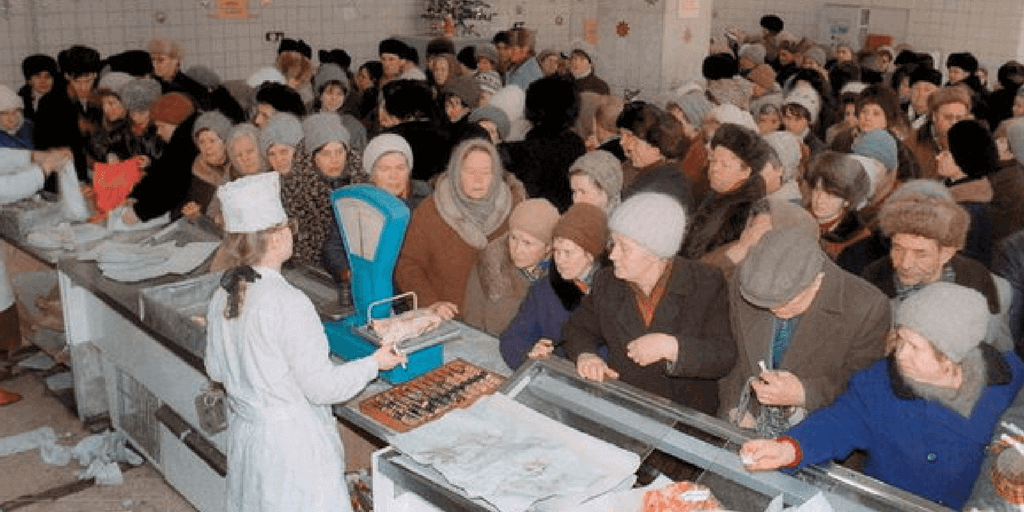Why does a market economy beat a planned economy?
A centrally planned economy, used by communist regimes and based on communist teachings, has failed for a number of reasons. These include a lack of innovation and flexibility and the inability to ensure the effectiveness of economic relations or to provide sufficient motivation for people to make wealth-promoting decisions.
A command economy causes poverty and human suffering
If one begins to look at the field of economics, the fundamental characteristics of a market that should be highlighted are first, the limited availability of resources and second, the fact that the price of those resources is dependent upon the interaction between demand and supply. In studying economics, it becomes clear that every attempt to somehow avoid the limitedness of resources or the law of demand and supply ends with the collapse of the command economy experiment.
In the worst-case scenario, a command economy can even lead to shortages of resources, an inefficient allocation of resources, or other unpredictable adverse effects. It should be noted that, a command economy demands additional resources to reduce negative impacts. In one way or another, the collapse of this kind of economic system will eventually occur. Unfortunately, this event can take up to 70 years to materialize and may, in effect, cause acute human suffering.

Unpredictable effects need extra attention and resources
History has shown that at some point in time, the relationship between the cost of resources and unpredictable market effects becomes such that the system is no longer able to respond to the increasing demands it faces. However, as discussed above, numerous examples demonstrate that a planned economy is doomed to fail. There are too many variables in the equation, and it is not possible to predict all of the secondary effects that can occur. No single, central organisation (e.g., The State Planning Committee) can alone comprehend the complex relationship that exists between capital, the labor force, resources, and intellectual capital.
The command economy eliminates the connection between achieving a better life through a career.
This is, however, not the main problem of the command economy. Perhaps, it will come as no surprise that there are more serious weaknesses with this economic model.
In a command economy, it is practically impossible to use demand as an input variable in planning, which is at least as problematic as the issues that are associated with the variables and secondary effects that economies experience. If the demand for resources (input) is a very important factor in a market economy, then in a command economy, also known as a planned economy, it is very difficult to adequately estimate the demand for resources (input). In a market economy, the companies respond flexibly to fluctuations in demand, which thereby affects the supply and enables companies to survive. On the other hand, in a command economy, it is not possible to respond to market feedback before the next planning period.
Competition increases motivation for innovation

Another major issue associated with the planned economy model is the lack of competition. In a market economy, there is constant pressure to improve one’s product and service, but this pressure does not exist in a command economy. As a result, there is no motivation for innovation, and it does not guarantee that economic actors will produce a quality product. This explains why the lion's share of innovations came from the free world in the 20th century.
In the command economies that existed during the 20th century, people were forced to steal intellectual property and frequently obtained it unofficially. Furthermore, if one examines the origins of the inventions that have greatly improved the standard of living for the world’s last two generations, in the field of medicine and technology alone, it is clear that the world’s command economies did not develop anything significant.
Command economy ignores the driving force of the economy
While command economies are subject to a number of issues, such as economic variables and secondary effects and a lack of input information, operational flexibility, and motivation for innovation, they also face other serious complications. In order for one to understand why the command economy model should be permanently discredited, in addition to the factors stated above, he or she must take another element into account.
In economics, the profit motive is the most important driving force, as earning a profit is essential for most companies to survive, if they are to serve as the backbone of a national economy. Contrary to what many individuals argue, the profit motive does not disappear in a command economy system. While the profit motive may also serve the public interests in a market economy, it conditions individuals to act only on the basis of personal gain in a planned economy. In the long term, if individuals are allowed to act on behalf of their personal gain in a command economy, this will lead to the formation of a situation in which there are two societal classes: the nomenclature and the poor.
This development is paradoxical because the ideological foundations of a command economy are based on the notion that a state’s economic organisation is meant to be the precise solution for addressing the disproportionate concentration of capital and the spread of inequality. The concentration of power in the hands of a few also increases the risk of corruption in a command system, which translates to additional costs for the economy. It is difficult to comprehend how the cost component can be adequately and fairly taken into account in the process of economic planning.
The concentration of power and the lack of feedback mechanisms and effective competition can create an environment where the central power has no particular motivation to improve the system and its efficiency. Instead of encouraging innovation amongst economic actors, a command economy system creates continuous stagnation.
The workers suffer

When it comes to addressing the labor force, replacing the principles of a market economy with those of a command economy is very problematic for workers. As is well known, the price of this resource would not be the result of the interplay between free market forces, but that of a planned economic exchange. On the one hand, a command economy leads to more social justice and eliminates unemployment. On the other hand, if a state ignores the law of supply and demand and the lack of appropriate pricing for laborers, a series of problems, which are similar to those that have been discussed above, will arise.
For instance, one cannot predict what kind of workforce he or she will need without the free market’s flexibility and feedback mechanisms. The plans are, therefore, made on an ideological rather than economic basis. In addition, if income does not depend on the demand of certain knowledge, skills, and higher cognitive abilities, then there will likely be a lack of motivation for workers to develop.
The command economy eliminates the connection between achieving a better life through a career. It also has the potential to cause market distortions or to lead to a situation where certain resources or skills are disproportionately assessed.
Black markets existed in planned economies as well
The limited availability of resources and the law of supply and demand are factors that are independent of ideology. This means that despite planning, regulating, commanding, or punishing and repressing, a command economy has a lot in common with a free market economy. If the State Planning Committee says that resource/product X costs Y and its demand significantly exceeds supply at this price level, then its production would simply lead to a deficit.
The price for resource X will then be determined by the law of supply and demand outside of the state’s official economic channels. As it is practically impossible to use demand as an input variable for the process of planning, the equilibrium price is much higher than it would have been in the “official system”. This is a simple explanation of why essential consumer goods often become luxury items in a command economy.
While state leaders may not tolerate black markets and attempt to get rid of unofficial market-oriented pricing mechanisms, they will, nonetheless, be faced with the need to combat “speculators” that exist within the command economy system. In the instance that a state establishes a command economy that is successful because of the use of repressive measures, then resource X at price Y will only be available for the nomenclature and not for the rest of society. This will, consequently, lead many other people to be in dire need of product X.
We must be careful not to fall into the same trap twice
In light of the above-mentioned argument, it is particularly worrisome that there are repeated discussions about using a command economy as a solution for various kinds of economic problems. It is even more distressing to think that educated individuals tend to support these claims. It is naive and problematic to regard planned economies as an economic mechanism that can be improved.
If the world is to avoid the formation of a society that is composed of the nomenclature and the poor; if people wish to avoid shortages of toilet paper; if individuals do not want food scarcities at some point in future, then it is society’s responsibility to take a stand against developments that could lead it, ever so slowly, towards a command economy.
Additional reading:
Investopedia: Capitalism vs. Socialism: What's the Difference?
Investopedia: Market Economy vs. Command Economy: What's the difference?
Eatwell, Milgate, Newman: Problems of the Planned Economy (Mcmillan 1990)